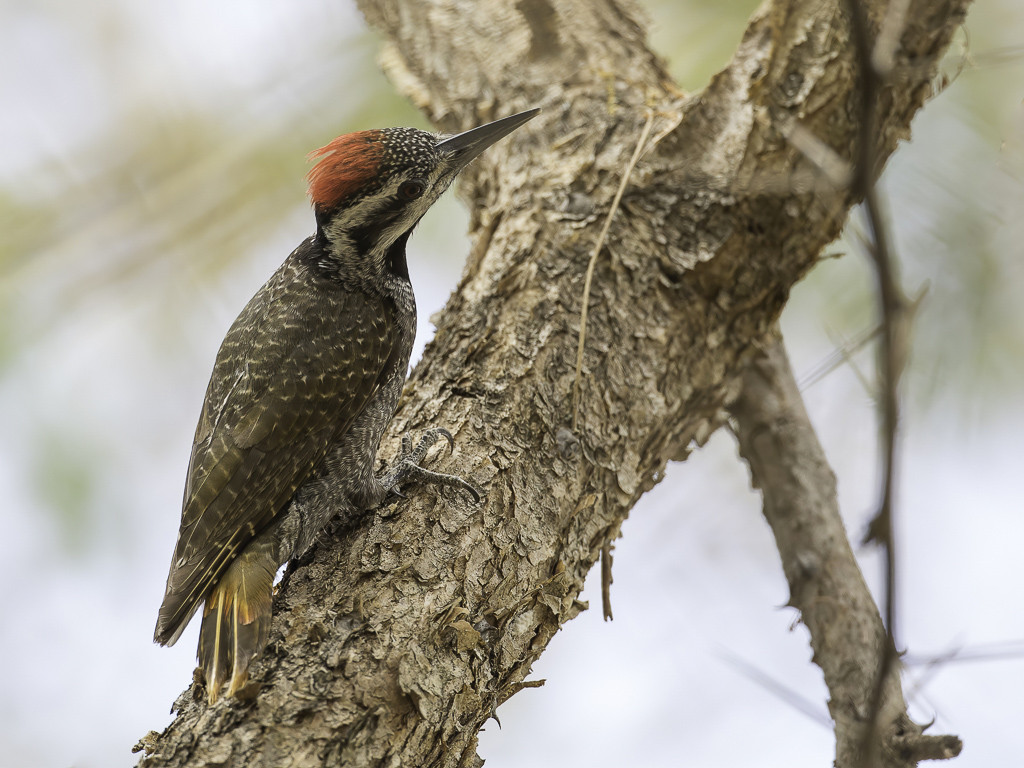
Bearded Woodpecker
Bearded Woodpecker
The Bearded Woodpecker: Nature’s Master Carpenter of the African Wilderness
Introduction
Among the many avian wonders of the African continent, the Bearded Woodpecker (Chloropicus namaquus) stands out as a fascinating species, both for its distinctive appearance and its ecological significance. With its striking plumage, powerful beak, and unmistakable drumming, this bird has long captured the attention of ornithologists and nature lovers alike.
In this comprehensive guide, we delve deep into the world of the Bearded Woodpecker, exploring its habitat, behavior, diet, and conservation status. Whether you’re a birdwatcher, researcher, or simply curious about African wildlife, this article offers a detailed look into one of nature’s most industrious creatures.
Taxonomy and Classification
The Bearded Woodpecker belongs to the family Picidae, which includes all woodpeckers, piculets, and wrynecks. It is classified under the genus Chloropicus, a group known for their adaptability and strong drumming behavior.
- Scientific Name: Chloropicus namaquus
- Common Name: Bearded Woodpecker
- Family: Picidae
- Order: Piciformes
This species was previously placed in the genus Dendropicos, but recent molecular studies have led to its reclassification.
Physical Description
The Bearded Woodpecker is the largest woodpecker found in sub-Saharan Africa. It is easily recognized by its:
- Size: Approximately 25–28 cm in length
- Coloration:
- Males have a red crown and nape
- Females lack the red crown but have similar markings
- Both sexes display a black-and-white streaked face with a prominent “beard” of black feathers
- Wings and Tail:
- Broad wings with white barring
- Strong, stiff tail feathers used for support while climbing
Its robust bill is perfectly adapted for chiseling into wood, a key feature that makes it an expert forager and nest-builder.
Habitat and Distribution
The Bearded Woodpecker is widely distributed across sub-Saharan Africa, favoring dry savannas, open woodlands, and forest edges.
Key Regions:
- Southern Africa: Namibia, Botswana, Zimbabwe
- Eastern Africa: Kenya, Tanzania
- Central Africa: Democratic Republic of Congo, Angola
- Western Africa: Nigeria, Ghana
These birds are highly adaptable and can be found in both lowland and montane regions, often near Baobab trees, which provide excellent nesting opportunities.
Behavior and Social Structure
Bearded Woodpeckers are typically seen alone or in pairs, though family groups may form during the breeding season. They are diurnal and spend most of their day:
- Foraging on tree trunks
- Drumming to communicate territory
- Excavating nesting cavities
Their drumming is not just a feeding technique but also a sophisticated form of communication. Each bird has a unique rhythm, which can be used to identify individuals.
Feeding Habits
These birds are primarily insectivorous, but they also consume plant matter when available.
Diet Includes:
- Beetle larvae
- Ants and termites
- Caterpillars
- Tree sap
- Berries and seeds
They use their strong beak to bore into wood and extract insects with their long, sticky tongue. Their feeding behavior plays a crucial role in controlling insect populations, making them vital to forest health.
Breeding and Nesting
Breeding occurs during the dry season when food is abundant. The Bearded Woodpecker is monogamous and both parents participate in raising the young.
Nesting Behavior:
- Nests are excavated in dead trees or branches
- The cavity is lined with wood chips
- Clutch size: 2–4 white eggs
- Incubation: ~13–15 days
- Fledging: 3–4 weeks after hatching
The young are fed regurgitated insects and are closely guarded by both parents until they are ready to fledge.
Vocalizations and Communication
In addition to drumming, Bearded Woodpeckers produce a range of vocalizations:
- “Kik-kik-kik” calls used for contact
- Alarm calls when threatened
- Soft chattering during courtship
These sounds are essential for maintaining pair bonds and defending territory.
Conservation Status
According to the IUCN Red List, the Bearded Woodpecker is currently listed as a species of Least Concern. However, localized threats do exist.
Conservation Highlights:
- Stable population trend
- Wide distribution
- Presence in protected areas
Despite its status, continued habitat monitoring is essential to ensure long-term survival.
Importance in Ecosystems
The Bearded Woodpecker plays a pivotal role in its ecosystem:
- Pest Control: Reduces populations of wood-boring insects
- Cavity Creation: Abandoned nests are used by other species like owls and bats
- Seed Dispersal: Helps in spreading plant species through fruit consumption
Their presence is often an indicator of a healthy, biodiverse environment.
Threats and Challenges
While not currently endangered, several threats could impact future populations:
- Deforestation: Loss of nesting trees
- Climate Change: Altered food availability
- Human Encroachment: Urban expansion into woodland areas
- Pesticide Use: Reduces insect prey
Conservation efforts must focus on habitat preservation and sustainable land use.
How to Spot a Bearded Woodpecker
If you’re planning a birdwatching trip in Africa, spotting a Bearded Woodpecker can be a highlight.
Tips for Identification:
- Look for large woodpeckers with black-and-white plumage and a “beard”
- Listen for loud drumming on dead trees
- Search near termite mounds and fallen logs
- Visit early in the morning when they are most active
Best Locations:
- Kruger National Park, South Africa
- Serengeti, Tanzania
- Okavango Delta, Botswana
Bring binoculars and a field guide for the best experience.
Frequently Asked Questions
1. What makes the Bearded Woodpecker unique among African woodpeckers?
Its size, powerful drumming, and distinctive facial markings set it apart. It is also one of the few African woodpeckers that excavates large nesting cavities used by other species.
2. Is the Bearded Woodpecker endangered?
No, it is currently listed as Least Concern by the IUCN, but habitat loss could pose future risks.
3. What do Bearded Woodpeckers eat?
They primarily feed on insects like beetle larvae and termites, but also consume fruits and seeds when available.
4. Where can I see a Bearded Woodpecker in the wild?
They are found across sub-Saharan Africa, especially in dry woodlands and savannas. National parks like Kruger and Serengeti are excellent spots.
5. Do Bearded Woodpeckers migrate?
No, they are non-migratory and tend to stay within their established territories year-round.
Conclusion
The Bearded Woodpecker is more than just a bird; it is a symbol of resilience, adaptation, and ecological balance. Its presence in the African wilderness is a testament to the intricate web of life that thrives in these landscapes. By understanding and appreciating this remarkable species, we take a step closer to preserving the natural heritage of Africa.
Whether you’re a seasoned ornithologist or a casual nature enthusiast, the Bearded Woodpecker offers a window into the fascinating world of avian ecology. Protecting its habitat ensures that future generations can continue to marvel at its beauty and utility.
